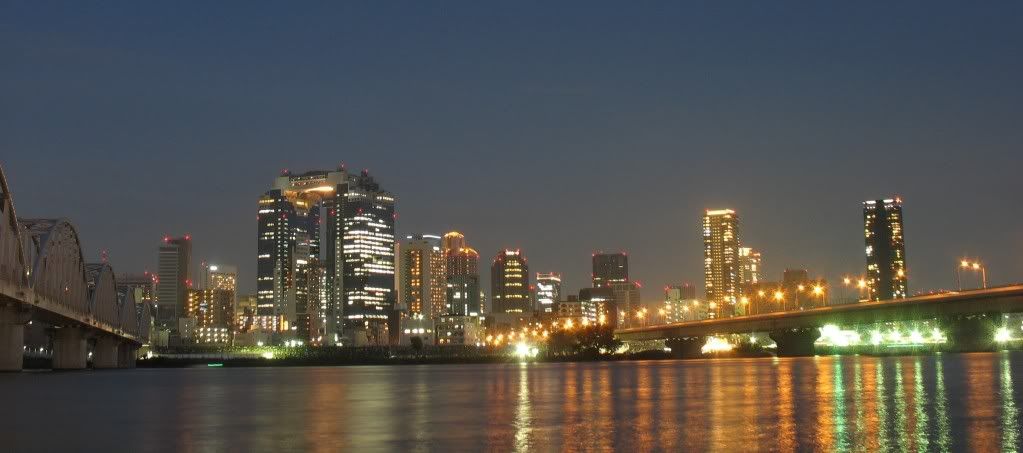

I have always been fascinated by the Japanese's dedication to whatever they do. They perfect their skill in any art that they indulge in, and they'd do it with honor. If you have seen the movie "The Last Samurai", you'd admire this trait from the Japanese.
Now I'm going to the Land of the Rising Sun. Specifically, Osaka. Upon going thru immigration and customs declaration, we got our train tickets. We we're on the last trip to Kyobashi. As expected, the train left exactly as scheduled. This is another trait that Japanese are known for, being on time.
We arrived at the Monterey La Soeur Hotel. Here's how the room looks like.
A peek from my window...
The hotel's facade...
We rode the train everyday to go to Suminodo area. During the summer, the sound of the "cicada" (Scientific name: Purana tigrana) may be something you can't help but notice. This loud shrill sound is produced by a pair of tymbals (special ribbed chitinous membrane) on the sidees of the first abdominal segment. These crickets spend a greater part of their 17-year lives underground as larvae and only emerge as adults to mate for a few weeks then die. That's sad.
The Japanese food is one of it's kind. Osaka offers one of the best cuisine there is in Japan. Takuyaki is popular here. These are dumplings with slices of octopus and other seafood mixed with meat and topped with barbecue sauce.
Here are some more of Osaka's cuisine...
Normally, their meals come with "misu" soup and cold tea. Softdrinks are not usually served with the meal but sold separately or you may grab one from the vending machines.
We visited a few temples as well.





We chanced upon geishas in Yasaka Shrine.
Yasaka Shrine is usually called "Gion-San" or "Yasaka-San". According to the tradition, its foundation dates back to 656 when Susanoono-mikoto was enshrined around here, which was long before the transfer of the capital to Kyoto.
The Gion Festival, one of the most famous festivals of Kyoto, is a festival held every July that derives from the Goryoe (a festival aimed at expelling revengeful spirits) held in 869, a year when plagues prevailed in many areas of Japan, in which participants prayed for the appeasement of evil spirits by putting up 66 halberds (equal to the number of provinces in those days) and sending portable shrines to Shinsen-En (south of the Nijo Castle). This festival has been held once a year since around 970.
Between the evening of December 31 and January 1, the "Okera-Mairi" Festival is organized and lots of people come to pray for good health for the New Year by receiving "Okera fire", made from the burning of the herb okera. Moreover, women wearing junihitoe (elegant and complex kimono originally worn by court-ladies) get together for the "karuta-Hajime" party, where they play the traditional "one-hundred poem cards".





I spent my weekend in Japan celebrating one of the most awaited annual event, the Yodogawa Fireworks Festival. They held it in Yodo River. It was attended by thousands. Here is a panoramic view of the Yodo River with Osaka's skyline.

The place was so crowded that I had to sit by the rocks along the river. Before the fireworks display started, I got a few shots of the Umeda Sky Building from a distance, one of the city's famous landmarks, and Osaka's seventh tallest building. I've seen this building before in Amazing Race. The two uppermost stories of the 40-story towers are connected with bridges and an escalator crossing the wide atrium-like space in the center.


The one-hour fireworks display was the best that I've seen. I've seen some fireworks display in a competition in the Philippines, a few from July 4 US Independence Day celebration, but this was a blast! It was spectacularly beautiful. I was in awe to see such unique and amazing display that some of them I've only seen for the first time.
We also toured Den-den town. Den-Den Town (Nipponbashi) is short for Denki no Machi (which means Electric Town in Japanese). This one-kilometer stretch features a plethora of video game stores, anime/manga related establishments, gadgets of all sorts, you name it.


And I've seen a few nice cars plying its street, including a Lamborghini. Cool!


We visited one of Osaka's favorite tourist spots, the Osaka castle. Now I can say that I've seen a real one.


Originally called Ozakajō, it is one of Japan's most famous castles, and played a major role in the unification of Japan during the sixteenth century of the Azuchi-Momoyama period. Osaka Castle is situated on a plot of land roughly one kilometer square. It is built on two raised platforms of landfill supported by sheer walls of cut rock, using a technique called Burdock piling, each overlooking a moat. The central castle building is five stories on the outside and eight stories on the inside, and built atop a tall stone foundation to protect its occupants from sword-bearing attackers.
After experiencing Japan, I say a country's culture plays a great role in shaping up its economy. The Japanese's great value for time and their desire to perfect their chosen discipline are just a few of the traits that makes them one of the most successful countries.
According to Soichiro Honda, founder of Honda Motor Company, “Success is 99 percent failure”.



















No comments:
Post a Comment